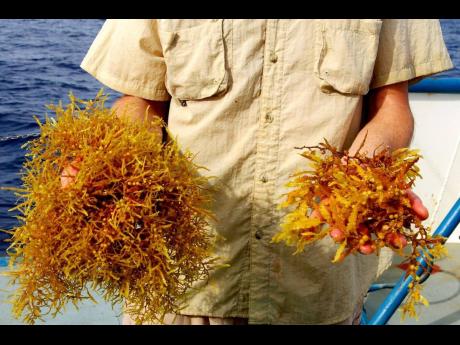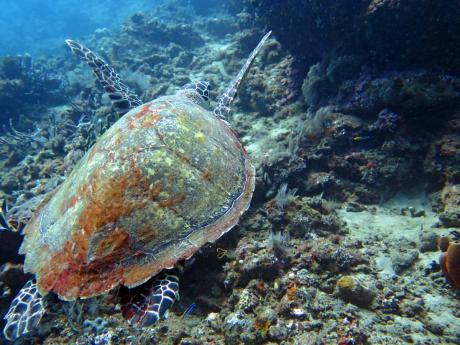Sun, Sea and sargassum
Against the background of recent concerns raised by Tourism Minister Edmund Bartlett about the impending invasion of sargassum being a threat to the tourism industry, marine scientist Dr Karl Aiken has a suggestion.
“Because of its effects on tourism, it is possible that the Tourism Enhancement Fund and the tax they impose on tourism visitors can be used to do some of the studies to manage sargassum in Jamaica and the greater Caribbean, which will be for the greater good of the Caribbean, because sargassum is a problem to us every couple of years. Some years are bad, some years are good, but it is very unpredictable,” Aiken told The Sunday Gleaner.
Recent satellite images show a floating mass of the seaweed stretching from West Africa to the Gulf of Mexico, which is now reported to be the biggest seaweed bloom in the world.
According to scientists, the algal explosion in the Atlantic Ocean and Caribbean Sea could signify a new normal. Deforestation and fertiliser use are among the factors thought to be driving the growth.
The brown seaweed has inundated beaches, causing an environmental nuisance.
Last week, during the 58th annual general meeting of the Jamaica Hotel and Tourist Association (JHTA), Bartlett said that the ministry was moving to deal with the looming sargassum threat before it swamps the Jamaican coastline.
“This one is from Brazil, and it is coming as a result of nutrients and climate-change activities, and therefore, this sargassum is potent and dangerous, because it destroys marine life. It destroys the fish sanctuary, and it comes in waves and covers large swathes of beaches and oceanfront. And, it has a hugely pungent odour,” Bartlett said.
“NEPA (National Environment and Planning Agency) says in nine months’ time it will be here. Let’s move fast so that we can deal with it ahead of its coming. We are having preliminary discussions with a team from MIT (Massachusetts Institute of Technology) that has done some forward technological breakthrough in the area of arresting and sinking the sargassum to the bottom of the sea, so that it doesn’t reach us at all.”
Aiken, who is a senior lecturer with the Department of Life Sciences in the Faculty of Pure and Applied Sciences at The University of the West Indies, Mona, is among scientists from across the world who are joining forces to understand and deal with the sargassum phenomenon.
Historically, uncertainty about when the sargassum wave will hit Jamaica makes it difficult to prepare for, due to its cyclical nature. Huge mats of the seaweed are held in check against the coastline of Brazil by winds and currents and when these slack off or falter, huge chunks, some as large as Jamaica, break off and start drifting towards the Caribbean.
“They drift northwards and go between Trinidad and Venezuela and Trinidad and Grenada, sometimes as far as Barbados. This happens every two to three or as much as up to five years. The intervals are unpredictable,” Dr Aiken noted.
“You have to rely on reports by shipping and also by satellite imagery. The fortunate thing is that you can pick it up on satellites that detect a thing called chlorophyll a, which is a signal that all phytoplankton (microscopic plants that live in the sea) give out. So we are able to track it and can see when some of the rafts tear off, which is like an alarm bell that goes off. Once they start to move, they are unstoppable because they are driven by winds and currents.”
CLIMATE CHANGE
Dr Aiken explained that climate change seems likely to make a bad situation worse and distance doesn’t matter, since one of the things that appears to be enhancing the growth of the sargassum mats is dust transported on wind currents from the Sahara Desert.
“The dust now seems to drift into Brazil due to climate change and settles in the water there, and the dust has nutrients in it that enhance or increase the growth of the sargassum mass. I think there are four species, and this recent one might be a fifth new species. They are very close to each other and only scientists can tell them apart, but the fact is that they behave in almost the same fashion as most of the other species,” he said.
“We can do nothing about it. That’s what you call a mesoscale, it means that it’s world size and has something to with the entire Atlantic. It’s not a localised thing like something around Jamaica or Trinidad. It’s enormous because it has connections with the other side of the Atlantic through the African Dust. It is large currents that are many times the size of Jamaica that help to pin it against Brazil and then allow it to break away and drive it north towards the Caribbean on the Eastern side.”
Once the seaweed mass enters the region, it can block out all the sea as far as the eye can see, but even then Jamaica should be grateful, according to Dr Aiken.
“In Jamaica, although we complain about it, we get relatively small strands of sargassum compared to other places. One year, all the bays of Grenada were covered, especially on the Atlantic side, where large quantities of sargassum covered the bays, which were bigger than Montego Bay, Discovery Bay, or Ocho Rios Bay. Based on photographs sent by colleagues, it was impossible to see any water at all,” he shared.
The marine scientist pointed out that, “It doesn’t kill anybody, but it smells bad; it prevents people from going into the water and I have found from working with it that it harbours some tiny things call hydroids, a kind of miniature jelly fish, which, if you brush against them, they sting you. They will not kill you, of course, but you may see children running from the water because they seem to be stung by the weeds, but it was really the little marine animals that live on the plants.”
Are there any positives to the sargassum infestation?
The survival rate and population growth of juvenile hawksbill turtles, one of four sea turtles found in Jamaica’s coastal waters, seem to be enhanced during times of sargassum infestation, noted marine scientist Dr Karl Aiken.
“Juvenile hawksbill turtles, which are just a few inches long, have an unusual crisscross, golden colour patterns on their back that exactly matches the pattern of sargassum seaweed mats. With the appearance of these large mats of sargassum, we believe that the number of hawksbill turtles are enhanced, because they can hide in the mats and feed, and in that way their numbers are slowly increasing, but we are still studying it,” he told The Sunday Gleaner.
“Another positive that may be coming from it is that dolphins use it to shelter and feed on other fish that are there, and their numbers are reportedly greater whenever you see the sargassum mats around. Also, the numbers of certain types of jacks which live under the mats are thought to increase over the years. But the unfortunate thing is that the economic devastation caused to the tourism industry far outweighs any benefits that come from the fisheries enhancement.”
Aiken noted that scientists once thought that they had found a solution when they toyed with the idea of producing an organic fertiliser for agriculture from sargassum, but that idea didn’t go far.
Based on the high sodium content, the sargassum could not be applied to plants, as it would kill them instead of generate growth, and cleaning the seaweed would require huge volumes of water to get rid of the salt, making it unfeasible. Extracting the sand enmeshed was another Herculean task.
Still, there is another problem, Dr Aiken explained: “You would have to scoop it up by mechanical means because of the amount. It would be too much to remove by hand, which would require a huge work force.”
Heavy duty cleaning of sargassum kills the beach, says marine scientist
Countries that have tried to clean up the sargassum mess by heavy duty means have paid a high economic cost, according to Dr Karl Aiken, a senior lecturer with the Department of Life Sciences in the Faculty of Pure and Applied Sciences at the University of the West Indies, Mona.
“They have found, to their amazement, that bringing in heavy duty equipment like bulldozers, tractors and dump trucks to remove sargassum from coastlines actually killed the beach. How do you kill a beach? The beach is alive because there are lots of eggs and nests of sea turtles and the weight of the heavy machinery crushes and kills them,” he explained.
“Also, a healthy beach is ventilated by hundred of holes made by ghost crabs and other sea creatures and when the heavy machinery drives on it, it crushes these inhabitants. What you end up with is a beach that is spoilt – the sand turns black and you wonder what it is; it’s the things that have died inside the beaches.”
The best way to clean up the pesky brown seaweed is by following the examples of Guadeloupe and Martinique, which have had success with mechanical harvesters linked to a big barge with a conveyor belt in front. It picks up the sargassum and puts it into the barge, which is disposed of elsewhere. But it is an expensive operation.
“This is a costly venture and not practical for most Caribbean states. In Jamaica, we can’t do that because it would be too expensive. We would need a physical barrier, like a floating fence, something like what you use to clean up an oil spill, and try and keep this in front of the beach. But the length of the floating barriers would need to be 20, 30, 40 miles long. In Cancún, it would need to be a hundred miles long,” said the marine scientist.
“A little sargassum is not a problem and it can be beautiful to look it, until it starts to decay in a few days in the heat and sunshine. Then it begins to produce massive quantities of gases of decay – mainly hydrogen sulfide, which is a toxic gas. It also produces vast quantities of carbon dioxide and methane, which are not gases people want to be around.”








